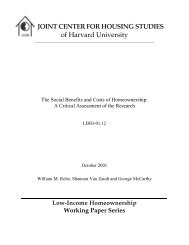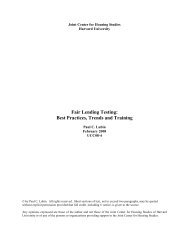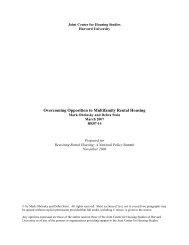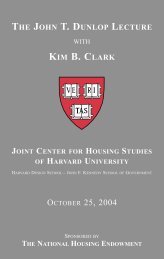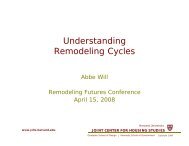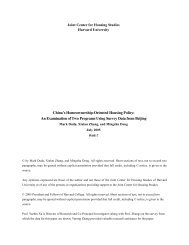please do not cite or circulate without permission of the authors
please do not cite or circulate without permission of the authors
please do not cite or circulate without permission of the authors
You also want an ePaper? Increase the reach of your titles
YUMPU automatically turns print PDFs into web optimized ePapers that Google loves.
in census tracts citywide.<br />
As mentioned above, we used GIS techniques to measure <strong>the</strong> distance from each<br />
sale in our database to all Nehemiah and Partnership sites. 12 Then we effectively created<br />
rings around each project to determine whe<strong>the</strong>r <strong>the</strong> prices <strong>of</strong> properties in <strong>the</strong> rings<br />
surrounding <strong>the</strong> developments were affected by <strong>the</strong>ir proximity to <strong>the</strong>se new<br />
homeownership developments. To give a sense <strong>of</strong> <strong>the</strong>se rings, Figure 5 shows an example<br />
<strong>of</strong> a Partnership development located on <strong>the</strong> Brooklyn/Queens b<strong>or</strong>der and its surrounding<br />
rings. The innermost ring extends 500 feet (usually one to two blocks) from <strong>the</strong> project;<br />
<strong>the</strong> second ring extends 1,000 feet (one to four blocks), and <strong>the</strong> outermost ring extends<br />
2,000 feet (three to eight blocks).<br />
Figure 5<br />
Partnership Development on Brooklyn/Queens B<strong>or</strong>der<br />
Park<br />
Cemetery<br />
12 Since all buildings in New Y<strong>or</strong>k City have been geocoded by <strong>the</strong> New Y<strong>or</strong>k City Department <strong>of</strong> City<br />
Planning, we used a “cross-walk” (<strong>the</strong> “Geosupp<strong>or</strong>t File”) which associates each tax lot with an x,y<br />
co<strong>or</strong>dinate (i.e., latitude, longitude, using <strong>the</strong> U.S. State Plane 1927 projection), police precinct, community<br />
district, and census tract. A tax lot is usually a building and is an identifier available to <strong>the</strong> homes sales and<br />
RPAD data. We are able to assign x,y co<strong>or</strong>dinates and o<strong>the</strong>r geographic variables to over 98 percent <strong>of</strong> <strong>the</strong><br />
repeat sales using this method. F<strong>or</strong> <strong>the</strong> Nehemiah and Partnership data, only <strong>the</strong> tax block on which <strong>the</strong><br />
property is located (which c<strong>or</strong>responds to a physical block) is available. After collapsing <strong>the</strong> Geosupp<strong>or</strong>t<br />
file to <strong>the</strong> tax block level (i.e., calculating <strong>the</strong> center <strong>of</strong> each block), we were able to assign an x,y<br />
co<strong>or</strong>dinate to 99.7 percent <strong>of</strong> <strong>the</strong>se projects.<br />
17



